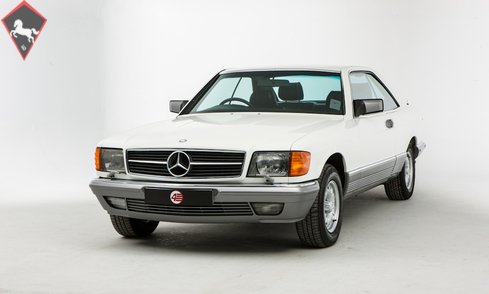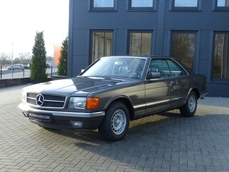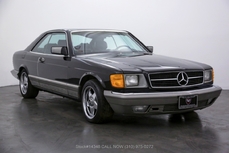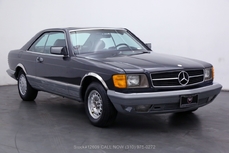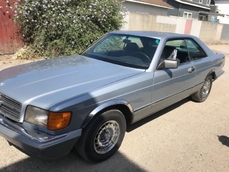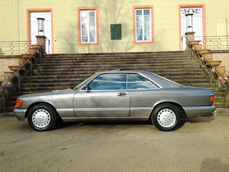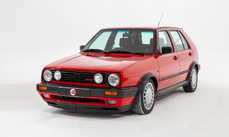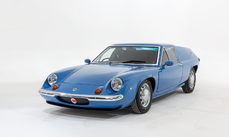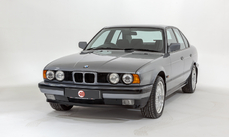Mercedes-Benz 500 SEC w126 500SEC 1985
General description :
Model History
The W126 was the series of S-Class Mercedes manufactured from 1979 to 1992. This made it the longest generation S-Class, with a production span of 12 years. The cars were offered with either straight six, V8, or turbocharged diesel engines.
With this generation of S-Class, Mercedes set out to improve the efficiency and aerodynamics over and above that of its predecessor. They achieved this through the use of lighter materials and wind tunnel testing. The W126 took six years of rigorous testing to develop before being unveiled. Mercedes really took their time to perfect the car, which is evident at first glance.
W126 series models were named in accordance to their engine size, and initially included the 280, 300, 380, and 500. Variants included the SE (standard wheelbase), SEL (long-wheelbase), SEC (coupé), and diesel models (SD and SDL).
The SEC was arguably the best coupe in the world when it arrived on the scene. Launched in 1981 the 500SEC was the initial flagship of the W126 Mercedes S-class range. Strictly speaking the SEC was known as the C126, although in practice most enthusiasts forget such technicalities. Customers for new SECs would have included company directors, football managers, and millionaires after something a little more subtle than a Rolls Royce.
Equipment
Classic White paintwork, Royal Blue leather upholstery, 15-hole light alloy wheels, Heated and electrically-adjustable front seats with driver and passenger memory function, Electric sunroof, Electric windows front and rear, Boot-mounted Engel refrigerator (factory option code 307), Limited slip differential, Cruise control, Automatic air conditioning, Self-levelling rear suspension, Leather steering wheel, Wood veneered dash and centre console, Front seat rear luggage nets, Folding rear headrests, ABS, Headlamp washers, Front fog lights, Heated door mirrors with nearside electric adjustment, JVC CD player, Automatic electric aerial, Mercedes first aid kit, Spare alloy wheel, Spare key.
Exterior
This late pre-facelift V8 SEC looks lovely in gleaming Classic White, the coachwork accented with lower panels in matte grey for that period two-tone Mercedes finish. The paint retains a good depth of shine and still looks crisp with only a handful of blemishes to report. This low mileage example has been the current owner’s pride and joy since she purchased it from us back in 2013 but understandably it has since picked up one or two small marks over the years.
To make this is a truly great example there are a couple of areas that in our opinion would benefit from cosmetic attention; a small amount of bubbling has started on both nearside arches, and the rear bumper is showing its age with some light scuff marks to the paint. Some lacquer peel is also visible on the offside rear quarter. The car is priced accordingly taking these and other factors into consideration. As such a low mileage example with the desirable 5-litre V8, this particular SEC represents great value for money.
VIEWINGS WELCOME BY APPOINTMENT ONLY /// RECENT PHOTOS AVAILABLE UPON REQUEST
Interior
A flagship model at the time, the 500SEC was well specified with climatic air conditioning, heated and electric front seats with memory, cruise control, an electric sunroof and electric windows, this particular car also boasting the rare factory option ‘307’ – a refrigerated cool box mounted in the boot! The lavish interior is further appointed with padded armrests front and rear, glossy walnut trim, a leather steering wheel, and CD player.
The Royal Blue upholstery makes for a striking contrast against the bright white exterior. Despite now 35 years old the leather remains surprisingly supple, with only a handful of discreet marks to report front and rear. Up above, the headlining has begun to sag (a common W126 issue) and glancing across the dash a perfectionist may note minor defects to the lacquered wood trim.
ENGINE & TRANSMISSION
The 500SEC has a wonderfully smooth V8, and the engine bay of this example is tidy with no signs of excessive wear to report. Out on the road, the four-speed automatic ‘box operates well with smooth changes through every gear. The car was last serviced in June 2020 and has just arrived back from a full check over and light re-commissioning at Tim Purslow Mercedes, the invoice for this work totalling in excess of £2,600. The MOT is valid until December 2021 however we do understand that further mechanical fettling will be required if the car is to be put back into regular use.
WHEELS, TYRES & BRAKES
The factory 15-hole alloy wheels appear in nice original condition but do present with some age-related wear including a few expected curb marks. The tyres and brakes have been checked and are all in fine operational condition; new brake pads were fitted all round in June 2020 and the brake fluid has just been changed at the current mileage.
Other recent underside work includes the replacement of both front suspension arm guide rods, both front lower balljoint gaiters, the front-to-rear fuel line, gear linkage bush, steering damper, and a small amount of welding to the nearside front inner wing – all carried out at Tim Purslow.
History File
This charming 500SEC was first registered in October 1985. It has now driven just 71k miles in the hands of only three registered keepers, the current owner having purchased it from us back in 2013. Up until the last couple of years the car has always been in general use and as such has been maintained accordingly. It was last serviced in June 2020 just a few hundred miles ago; work included an oil and filter change, new spark plugs, and new brake pads all round.
Upon arrival with us the car was sent to our trusted marque specialist, Tim Purslow Mercedes, for them to check the car over and remedy any MOT failures. The current owner has now spent in excess of £2,600 with Tim Purslow preparing the car for sale. However, to lift the car further some additional cosmetic and mechanical work will be required if it is to be put back into regular use. Unfortunately, the current owner is no longer in a position to have any additional work carried out, and so these factors have been reflected in the price.
http://www.4starclassics.com/for-sale/mercedes-w126-500sec-for-sale/
1985 Mercedes-Benz 500 SEC w126 500SEC is listed sold on ClassicDigest in Kingsley by 4 Star Classics for £15495.
Car Facts
Car type : Car Make : Mercedes-Benz Model : 500 SEC w126 Model Version : 500SEC Engine size : 5.0 Model Year : 1985 Sub type : Van Location : Hampshire
Sold
Seller Information
Sold
People who viewed this Mercedes-Benz 500 SEC w126 also viewed similar Mercedes-Benz listed at ClassicDigest
Other cars listed for sale by this dealer
About Mercedes-Benz
In the annals of automotive history, the journey of Mercedes-Benz is a tale that unfolds with the ingenuity of its founding pioneers. In the year 1886, Karl Benz crafted the Benz Patent Motorwagen, a creation that would go down in history as the world's inaugural automobile. Unbeknownst to him, this moment marked the genesis of what would evolve into the most illustrious premium car manufacturer globally. The financial underpinning of this pioneering venture, interestingly, was provided by Karl Benz's wife, Bertha Benz, demonstrating a remarkable partnership that would set the tone for Mercedes-Benz's legacy.A parallel narrative emerged not far away, as Daimler-Motoren-Gesellschaft, founded by Gottlieb Daimler and Wilhelm Maybach, entered the scene. In 1901, they unveiled their automobile under the now-famous moniker "Mercedes," meaning "godsend" in Spanish. This name was bestowed upon the car at the behest of Emil Jellinek's daughter, the distributor for Daimler-Motoren-Gesellschaft. The wheels of innovation were set in motion.
Fast forward to 1926, a pivotal year that witnessed the merger of Daimler with Benz & Cie., culminating in the birth of Daimler-Benz. The amalgamation saw the adoption of "Mercedes-Benz" as the distinguished trademark for their automobiles, fusing the legacies of two visionary entities into one.
Contrary to perceptions of conservatism, the trajectory of Daimler-Benz unfolds as a chronicle of industry firsts. From the introduction of the honeycomb radiator to the float carburetor, and the pioneering implementation of four-wheel brakes in 1924, Daimler-Benz consistently pushed the boundaries of automotive innovation. The diesel-powered Mercedes-Benz 260 D in 1936 marked the inception of diesel engines in passenger cars. The iconic Mercedes-Benz 300SL Gullwing made history as the first car with direct fuel injection, albeit the Gutbrod's tiny 2-stroke engine can claim precedence.
Safety innovations became a hallmark, with Béla Barényi's patented safety cell design in the "Ponton"-models in 1951, featuring front and rear crumple zones. The W116 450SEL 6.9 saw the introduction of the Anti-Lock Brake system (ABS), another pioneering safety feature. From the first production airbags and beyond, the legacy of "firsts" continued to be etched into the fabric of Daimler-Benz.
Over its centennial journey, Mercedes-Benz has not merely produced cars but has sculpted automotive icons. The SSKL, 710 SSK Trossi Roadster, 770K Grosser, 540K Spezial Roadster, 300SL Gullwing, w100 600 Pullman, w111 280SE 3.5 Flachkühler, w113 230SL Pagoda, w109 300 SEL 6.3, and w201 2.3-16 Cosworth stand testament to the brand's commitment to engineering excellence.
The roaring Silver Arrows, or "Silberpfeile," including the W 25, W 125, W154, W165, and W196, created a legacy of dominance on the racetrack. These machines were not merely cars; they were expressions of precision, speed, and an indomitable spirit that left their competitors in the dust.
As Mercedes-Benz marches into the future, it does so not just as an automaker but as a custodian of a legacy, a torchbearer of innovation, and a beacon of automotive excellence. The road ahead is sure to witness the continued fusion of cutting-edge technology, timeless design, and an unwavering commitment to setting new standards in the world of automobiles.
One luminary figure who left an indelible mark was Béla Barényi, often heralded as the "father of passive safety" for his pioneering work in safety engineering. His patented safety cell design, featuring front and rear crumple zones, became a hallmark of Mercedes-Benz's commitment to occupant safety, setting new standards that reverberated throughout the automotive world.
Moving through the chronicles, the collaborative genius of Wilhelm Maybach, alongside Gottlieb Daimler, laid the foundation for Daimler-Motoren-Gesellschaft. Their innovations not only birthed the first Mercedes but established a culture of relentless pursuit of technological excellence that remains integral to Mercedes-Benz's DNA.
In the post-merger era of 1926, Ferdinand Porsche emerged as a prominent figure within Mercedes-Benz. His work on the Mercedes-Benz S-Type, a supercharged race car, garnered acclaim and set the stage for a legacy that extended far beyond the marque. Porsche's impact would later extend to his eponymous company, but his influence at Mercedes-Benz during those formative years was pivotal.
As the 20th century progressed, the legendary Rudolf Uhlenhaut emerged as a key figure. Uhlenhaut, an accomplished engineer and the driving force behind the iconic Silver Arrows, played a crucial role in Mercedes-Benz's dominance in motorsports. His engineering prowess and attention to detail were instrumental in creating some of the most formidable racing cars of the era.
In the latter half of the century, figures like Bruno Sacco, the head of design at Mercedes-Benz from 1975 to 1999, left an indelible imprint on the brand's aesthetic identity. Sacco's design philosophy, characterized by clean lines and timeless elegance, shaped iconic models like the W126 S-Class and the W201 190E, solidifying Mercedes-Benz's reputation for luxury and sophistication.
The narrative would be incomplete without acknowledging the contributions of engineers like Hans Scherenberg, whose leadership in the 1970s ushered in a new era of technological innovation at Mercedes-Benz. Scherenberg's tenure saw the development of groundbreaking technologies, including the Anti-Lock Brake system (ABS) and the introduction of airbags in production cars.
